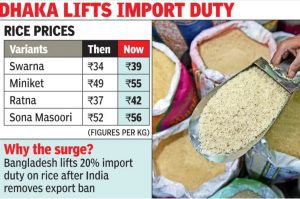Rice Prices Soar in Kolkata Markets — A familiar staple of Bengali households, rice, is once again at the center of household budgets and political discussions in Kolkata. With the recent resumption of rice exports to Bangladesh, the city’s wholesale and retail markets have reported a sudden surge in prices, sparking concerns among consumers and traders alike.
According to traders in Posta, Burrabazar, and major suburban mandis, the wholesale rate of several premium varieties has increased by ₹3–₹5 per kilogram in just the past week. The ripple effect has already reached neighborhood shops and local markets, where families are cutting back on premium long-grain varieties and shifting to cheaper alternatives.

Rice Prices Soar in Kolkata Markets: A Staple Under Pressure
Rice is more than just food in Bengal — it is an integral part of cultural identity, festivals, and daily meals. A typical middle-class Bengali household consumes anywhere between 20–25 kilograms of rice a month, depending on family size. Any fluctuation in price therefore immediately affects household budgets.
“Last month, we bought Miniket rice at ₹54 per kilo. Now the same shop is charging ₹59. For a family of five, that difference adds up quickly,” said Mousumi Dutta, a homemaker from Behala. Like many others, she has switched to medium-grain rice, which is priced between ₹42–₹45, sacrificing the polished quality and aroma that premium rice varieties carry.
Traders Point to Exports and Demand
Wholesale rice traders attribute the price hike primarily to the resumption of exports to Bangladesh. After months of restrictions aimed at ensuring domestic stability, the Indian government permitted shipments to its eastern neighbor earlier this month.
“Bangladesh is facing shortages due to floods in Sylhet and Khulna regions. Naturally, the demand is high, and Indian exporters are responding. That demand pressure reflects immediately on our domestic markets,” explained Rajesh Agarwal, a wholesaler in Burrabazar.
He added that while India is one of the world’s largest rice producers, the interconnected nature of regional trade means that even small shifts in export policy can alter local pricing structures.
Retailers Caught in the Middle3


For small kirana shop owners and rice dealers, the situation is complicated. Retailers say customers are complaining, bargaining harder, and in many cases, buying reduced quantities.
“We cannot stockpile because wholesale rates keep changing. Customers blame us, but our profit margin is shrinking too,” said Shyamal Saha, who runs a grocery shop in Jadavpur.
Some shops have even begun sourcing directly from smaller mills in North 24 Parganas and Hooghly, bypassing major distributors, in an attempt to offer customers lower prices. However, supply inconsistencies remain a challenge.
Consumers Opt for Cheaper Varieties
The most visible impact has been a shift in consumer preference. Popular premium brands such as Miniket, Gobindobhog, and Banskathi are witnessing reduced demand, while cheaper varieties like IR-36 and Swarna are moving faster.
“Earlier, we always bought Banskathi for pujas and family gatherings. Now, we are mixing it with cheaper varieties to manage costs,” admitted Prabir Ghosh, a resident of Dum Dum.
Nutritionists warn that cheaper varieties may lack the same micronutrient content as premium polished rice, though most families say budgetary concerns leave them with little choice.
Farmers Caught Between Demand and Profit
Ironically, farmers in districts like Burdwan, Birbhum, and Nadia are not always benefiting from the price surge. Agricultural labor costs, fertilizer prices, and unpredictable monsoon rains continue to offset potential profits.
“Middlemen and traders control the chain. Farmers may get a slightly higher price, but input costs eat into everything. The urban consumer feels the pinch, but rural cultivators don’t see big benefits either,” said Dr. S.K. Roy, an agricultural economist at Bidhan Chandra Krishi Viswavidyalaya.
Government Response and Price Monitoring
The West Bengal government has taken note of the price fluctuations. Food and Supplies Department officials have begun monitoring wholesale markets and have warned traders against hoarding.
“We are keeping a close watch. If needed, we will release additional stocks through the Public Distribution System (PDS) to ease market pressure,” said a senior official.
There are also talks of initiating joint consultations with Bangladesh officials to regulate export flows in a manner that does not destabilize local prices.
Wider Economic and Political Implications
The timing of the rice price surge could have broader political implications. With state elections on the horizon, rising food inflation is likely to become a contentious issue. Opposition parties have already started blaming the state government for failing to protect consumer interests.
Economists warn that if the trend continues, it could contribute to higher food inflation in the consumer price index, further straining middle-class and lower-income households.
The Road Ahead
Experts say the situation is unlikely to stabilize immediately. Prices may fluctuate depending on harvest outcomes in the coming months and the scale of export commitments to Bangladesh. A good monsoon and effective government intervention could help, but if global demand continues to rise, the pressure on domestic markets will remain.
For now, households in Kolkata are left juggling monthly budgets, shopkeepers are adjusting supply channels, and policymakers are under pressure to balance international trade commitments with local affordability.
External References for Context
- Food and Agriculture Organization (FAO) on Rice Trade
- Government of India – Department of Food & Public Distribution
- World Bank Report on Food Inflation in South Asia
- Reserve Bank of India – Inflation and Food Prices
Also read: Home | Channel 6 Network – Latest News, Breaking Updates: Politics, Business, Tech & More

